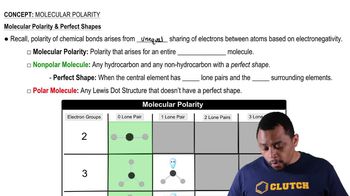Considering their chemical structure, why are the melting points of oils lower than those of fats?
Ch.7 States of Matter and Their Attractive Forces
Chapter 4, Problem 7.46
Draw a possible hydrogen bond between a molecule of cholesterol and a molecule of water.
 Verified step by step guidance
Verified step by step guidance1
Identify the functional groups in cholesterol that can participate in hydrogen bonding. Cholesterol has a hydroxyl group (-OH) that can act as a hydrogen bond donor or acceptor.
Recognize that water (H₂O) can also participate in hydrogen bonding, with its oxygen atom acting as a hydrogen bond acceptor and its hydrogen atoms acting as hydrogen bond donors.
Draw the structure of cholesterol, highlighting the hydroxyl group. The hydroxyl group is typically located at the end of the steroid structure of cholesterol.
Draw a water molecule near the hydroxyl group of cholesterol. Position the water molecule so that one of its hydrogen atoms is near the oxygen atom of the hydroxyl group in cholesterol, or the oxygen atom of water is near the hydrogen atom of the hydroxyl group.
Illustrate the hydrogen bond as a dashed line between the hydrogen atom of water and the oxygen atom of the hydroxyl group in cholesterol, or between the oxygen atom of water and the hydrogen atom of the hydroxyl group in cholesterol.

Verified Solution
Video duration:
5mWas this helpful?
Key Concepts
Here are the essential concepts you must grasp in order to answer the question correctly.
Hydrogen Bonding
Hydrogen bonding is a type of weak chemical bond that occurs when a hydrogen atom covalently bonded to a highly electronegative atom, such as oxygen or nitrogen, experiences an attraction to another electronegative atom. In the context of cholesterol and water, the hydrogen atoms in water can form hydrogen bonds with the oxygen atoms in cholesterol, facilitating interactions between these molecules.
Recommended video:
Guided course

Hydrogenation Reactions Concept 1
Cholesterol Structure
Cholesterol is a lipid molecule characterized by a complex structure that includes a hydrophobic steroid ring system and a small hydrophilic hydroxyl group. This unique structure allows cholesterol to interact with both hydrophobic and hydrophilic environments, making it essential for membrane fluidity and stability in biological systems, as well as influencing its interactions with water molecules.
Recommended video:
Guided course

Structural Formula Concept 2
Polarity of Water
Water is a polar molecule, meaning it has a partial positive charge on one side (hydrogens) and a partial negative charge on the other (oxygen). This polarity allows water to form hydrogen bonds with other polar molecules, such as cholesterol. Understanding the polarity of water is crucial for predicting how it interacts with various substances, including lipids and proteins.
Recommended video:
Guided course

Molecular Polarity (Simplified) Concept 1
Related Practice
Textbook Question
10
views
Textbook Question
ALLIED Health One of the main triglycerides in palm oil is tripalmitin. It contains three fatty acids with carbon designations of, [16:0]. Draw the structure of tripalmitin. Would you expect this molecule to be a solid or liquid at room temperature?
9
views
Textbook Question
Compare the structure of a soap molecule to a phospholipid and explain why a soap’s polar head is smaller than that of a phospholipid.
17
views
Textbook Question
Describe other components present in a cell membrane and their relative location.
17
views
Textbook Question
Mayonnaise is a thick mixture containing oil, vinegar (water-based), and eggs; the eggs contain a phospholipid molecule called lecithin. Mayonnaise cannot be made without lecithin. Explain why lecithin is a critical ingredient.
15
views
